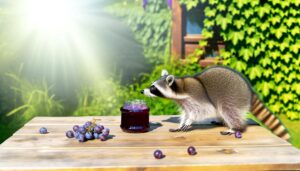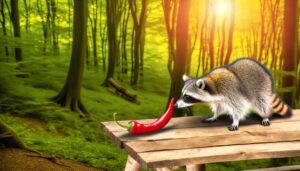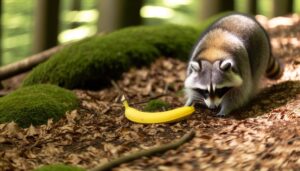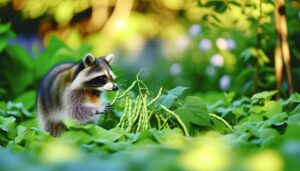Do Raccoons Eat Dead Humans: Understanding Their Scavenging Behavior
Raccoons (Procyon lotor) are omnivores known for their versatile feeding habits, which include scavenging. Evidence from historical and forensic case studies indicates that raccoons can indeed scavenge on human remains when food sources are scarce or limited.
Opportunistic by nature, raccoons consume a variety of available food, including carrion. Environmental factors such as habitat and food scarcity greatly influence their scavenging behavior.
Documented cases provide insights into how raccoons interact with human remains, altering crime scenes and impacting post-mortem investigations. Understanding these behaviors sheds light on their role in both natural and urban ecosystems.
Continue to discover the complexities of raccoon feeding habits.
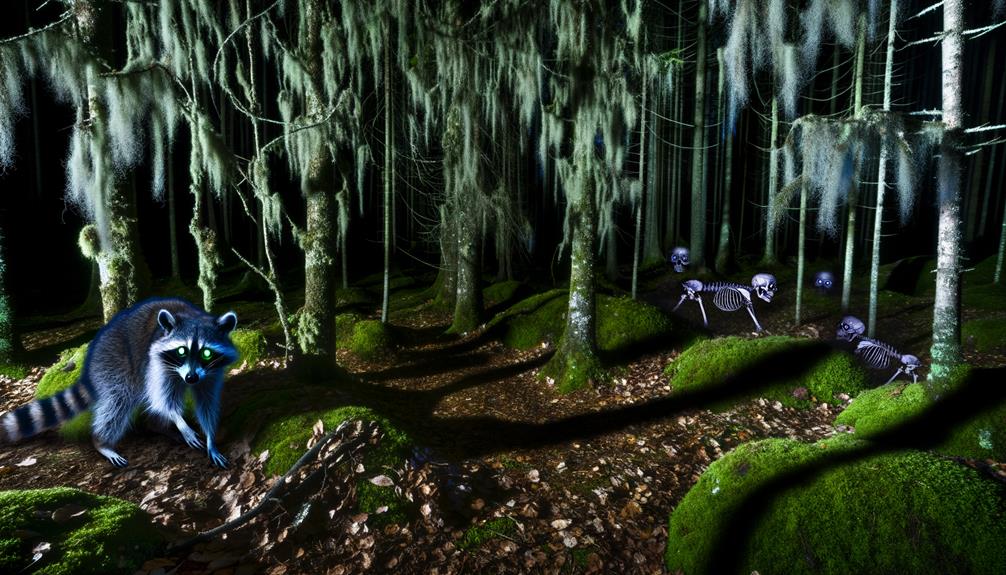
Key Takeaways
- Raccoons are known to scavenge on human remains when other food sources are scarce or unavailable.
- Historical incident reports and forensic case studies document raccoons scavenging on deceased humans.
- Raccoons' opportunistic feeding habits lead them to consume unconventional food items, including human remains.
- Wildlife experts observe raccoons scavenging on human bodies in both urban and natural environments.
- Raccoons' omnivorous diet and nocturnal scavenging behavior make them capable of altering crime scenes involving human remains.
Raccoon Dietary Habits

Raccoon dietary habits are diverse and omnivorous, encompassing a wide range of both plant and animal matter. Scientifically known as Procyon lotor, raccoons exhibit a versatile feeding behavior that includes fruits, nuts, seeds, insects, small vertebrates, and aquatic organisms like crayfish. Studies indicate that their diet varies seasonally: during warmer months, they consume more fruits and insects, while colder months see increased ingestion of nuts and animal proteins.
Their adaptability allows them to thrive in disparate environments, from urban areas to rural landscapes. This generalist diet is a pivotal factor in their success as a species, aiding in their survival and proliferation across diverse habitats. Understanding these habits is essential for comprehending raccoon ecological dynamics.
Scavenging Behavior
Frequently demonstrating opportunistic tendencies, raccoons engage in scavenging behavior as a means to supplement their diet, particularly in environments where food resources fluctuate. This adaptive behavior is vital for their survival, allowing them to exploit a variety of nutritional sources, including carrion. Studies indicate that raccoons do not distinguish between different types of carrion, consuming whatever is available to meet their energy needs. Such behaviors are observed in both urban and rural settings, where raccoons scavenge from garbage bins, roadkill, and other accessible remains.
| Scavenging Source | Evidence of Consumption |
|---|---|
| Garbage bins | High |
| Roadkill | Moderate to High |
| Animal carcasses | High |
| Human remains | Rare but documented |
Understanding raccoons' scavenging habits is necessary for wildlife management and public health considerations.
Opportunistic Feeding
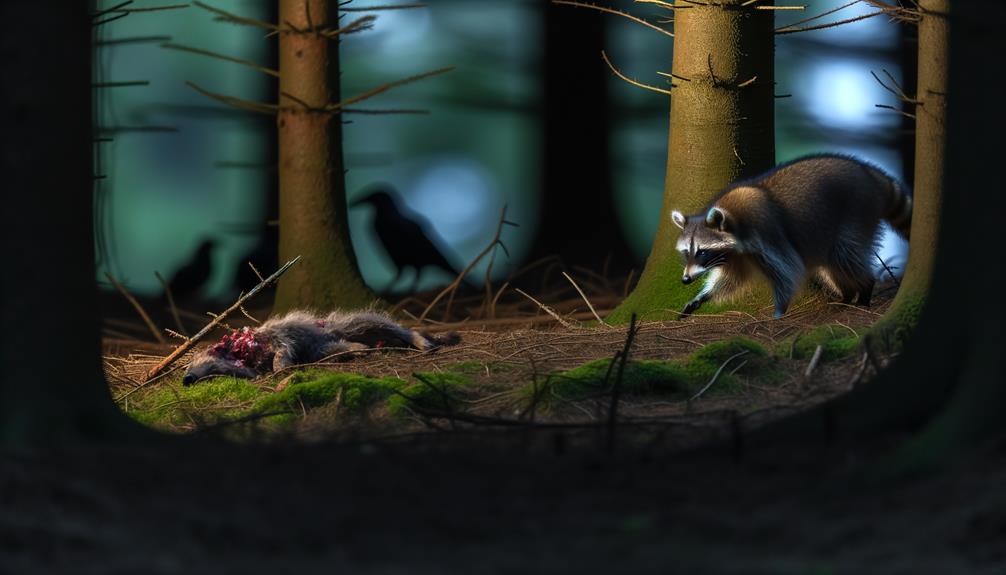
Raccoons exhibit opportunistic feeding behavior, influenced by their natural scavenging instincts and omnivorous dietary habits. These adaptive traits enable raccoons to thrive in urban environments where diverse food sources are readily accessible.
Consequently, their feeding patterns may include consuming carrion, thereby raising questions about their interactions with deceased humans.
Scavenging Natural Instincts
Exhibiting opportunistic feeding behavior, raccoons possess scavenging instincts that drive them to consume a wide variety of food sources, including carrion. These nocturnal mammals are highly adaptable and capable of exploiting available resources. Scavenging is a natural strategy that enhances their survival by providing a steady food supply, particularly when other sources are scarce. Evidence from various ecological studies indicates that raccoons will investigate and consume dead animals, including humans, if encountered. This behavior is not uncommon among many wildlife species, as it reduces the energy expended in hunting and increases caloric intake. Understanding raccoon scavenging behavior is crucial for managing their interactions with human environments and mitigating potential risks.
| Behavior | Description | Implications |
|---|---|---|
| Scavenging | Consuming dead animals, including humans | Increases survival rates |
| Opportunistic | Utilizing available food resources | Adaptability in diverse environments |
| Nocturnal | Active primarily at night | Reduced human-wildlife conflict |
| Resourceful | Exploiting various food sources | Resilience in changing conditions |
| Investigative | Examining potential food items | Efficient energy use |
Omnivorous Dietary Habits
Ranging widely in their dietary choices, raccoons demonstrate omnivorous feeding habits that include fruits, vegetables, nuts, insects, small mammals, and carrion. These feeding behaviors underscore their adaptability and ability to thrive in diverse environments.
Scientific studies have shown that raccoons are opportunistic feeders, often consuming what is most readily available. This includes scavenging on dead animals, known as carrion, which provides them with essential nutrients. Their varied diet, coupled with their keen sense of smell and dexterous front paws, allows them to exploit a broad array of food sources.
This dietary flexibility is a key factor in their survival and reproductive success, enabling them to sustain themselves in both natural and human-altered landscapes.
Urban Environment Behavior
In urban environments, raccoons display remarkable opportunistic feeding behaviors that enable them to exploit a variety of anthropogenic food sources. Studies indicate that raccoons frequently forage in residential trash, compost bins, and pet food left outdoors, capitalizing on the abundance of easily accessible nourishment. This adaptive behavior is facilitated by their dexterous forepaws and keen sense of smell.
Additionally, raccoons are known to scavenge carrion, including deceased wildlife, and potentially dead humans, though such occurrences are rare and dependent on the availability of other food sources. Their diet in urban settings reflects their flexible foraging strategies and ability to thrive in human-dominated landscapes, underscoring their role as highly adaptable urban omnivores.
Environmental Factors
Environmental factors play a significant role in determining whether raccoons will scavenge on deceased human bodies. Key factors include the availability of other food sources, weather conditions, and habitat.
In areas where natural food is scarce, raccoons are more likely to scavenge on unconventional food sources, including carrion. Weather conditions such as extreme cold or heat can also influence scavenging behaviors, as can the presence of cover and safety from predators.
Additionally, urban environments with limited natural food supplies and increased human activity may drive raccoons to scavenge more opportunistically. Understanding these environmental variables is crucial in evaluating the likelihood of raccoon scavenging behaviors in various settings.
Documented Cases
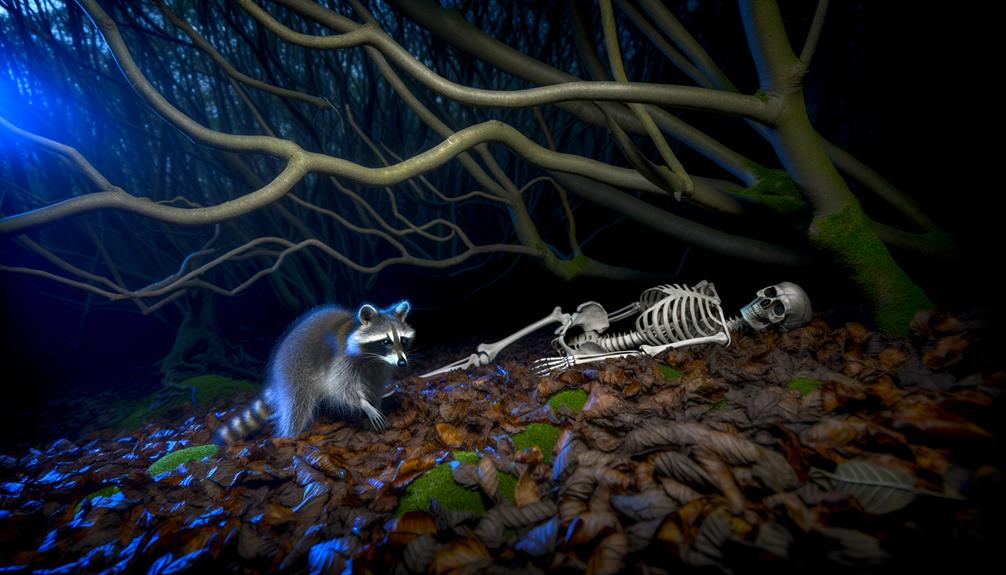
To understand the potential interactions between raccoons and human remains, it is essential to examine historical incident reports, forensic case studies, and wildlife expert observations.
Analysis of documented cases provides valuable insights into the circumstances and frequency of such occurrences.
This evidence-based approach helps clarify whether raccoons exhibit scavenging behavior towards dead humans.
Historical Incident Reports
Documented cases provide vital insights into the interactions between raccoons and deceased humans, offering a foundation for understanding this behavior. Historical incident reports indicate that raccoons, being opportunistic omnivores, occasionally scavenge on human remains.
These reports, often originating from forensic investigations and wildlife studies, highlight instances in which raccoons have been found consuming soft tissues. Such behavior is typically observed in locations where human remains are left exposed and accessible. Although these instances are relatively rare, the documented evidence confirms that raccoons do not inherently differentiate between animal and human carrion.
Understanding these interactions is essential for forensic science, as it helps in determining post-mortem intervals and evaluating the extent of animal scavenging on human remains.
Forensic Case Studies
Forensic case studies provide concrete examples of raccoons scavenging on human remains, thereby offering valuable data on the extent and nature of this behavior. These documented cases enable forensic experts to understand the forensic implications of animal scavenging, particularly in post-mortem intervals and body decomposition stages.
Several key findings have emerged from these studies:
- Raccoon Scavenging Behavior: Evidence shows raccoons can significantly alter a crime scene by scavenging.
- Forensic Timing: Scavenging activities can provide insights into the time since death.
- Tissue Consumption: Specific patterns of tissue consumption by raccoons have been observed.
- Impact on Identification: Scavenging can complicate the identification of remains due to tissue damage.
These findings contribute to a more thorough understanding of post-mortem changes influenced by wildlife.
Wildlife Expert Observations
Building on forensic case studies, wildlife expert observations offer additional insights into the scavenging behavior of raccoons through documented cases in natural settings. These accounts highlight raccoons' opportunistic feeding habits, which include scavenging on carrion, including human remains under specific conditions. The following table summarizes key observations from documented cases:
| Study Location | Key Findings |
|---|---|
| Urban Park | Raccoons found scavenging on animal and human remains, primarily at night. |
| Forest Reserve | Documented instances of raccoons feeding on decomposed bodies. |
| Suburban Area | Raccoons reported to scavenge on roadkill, occasionally human remains. |
| Rural Region | Increased scavenging behavior in areas with limited food sources. |
Such observations underscore the adaptability of raccoons to various environments, influencing their scavenging patterns, including potential human remains.
Human Remains Encounters
Throughout various case studies, raccoons have been observed scavenging on human remains under certain environmental conditions. This phenomenon is generally documented in scenarios where natural food sources are scarce, and human remains are accessible.
Key factors influencing such encounters include:
- Availability of Food Resources: Limited natural food sources drive raccoons to scavenge unconventional items.
- Location: Proximity to human habitation or disposal sites can increase the likelihood of interaction.
- Time of Year: Seasonal changes affecting food supply may also affect scavenging behavior.
- Human Activity: Increased human presence or activity can inadvertently provide raccoons with more scavenging opportunities.
Raccoon Anatomy and Diet

Raccoons are omnivorous mammals equipped with sharp teeth designed for processing a variety of food sources. Their diet includes fruits, vegetables, small animals, and carrion, indicating a highly adaptable feeding behavior.
The anatomical structure of their teeth allows them to efficiently consume both plant matter and animal tissue, which plays a critical role in their survival and ecological impact.
Omnivorous Dietary Habits
With their highly adaptable digestive systems, raccoons exhibit omnivorous dietary habits that enable them to consume a wide range of food sources. These versatile feeders can thrive in diverse environments by exploiting various nutritional opportunities.
Their diet typically includes:
- Fruits and Vegetables: Raccoons commonly consume berries, nuts, and garden crops.
- Small Animals: They hunt and eat fish, insects, and small mammals.
- Human Food Waste: Urban raccoons often scavenge in garbage bins for discarded food items.
- Carrion: They are opportunistic feeders and will consume dead animals when available.
Such dietary flexibility not only facilitates their survival across different habitats but also helps them adapt to seasonal and environmental changes. This omnivorous nature underscores their role as both predator and scavenger in the ecosystem.
Sharp Teeth Function
The omnivorous dietary habits of raccoons are supported by their sharp teeth, which are anatomically adapted to process a variety of food sources efficiently. Their dental structure includes incisors, canines, premolars, and molars, each serving a unique role in their feeding behavior. The sharp canines are particularly effective for puncturing and gripping prey, while the molars are adapted for grinding plant material. This dual functionality allows raccoons to consume a broad diet ranging from fruits and nuts to small animals and carrion.
| Tooth Type | Function |
|---|---|
| Incisors | Cutting |
| Canines | Puncturing, gripping |
| Premolars | Shearing |
| Molars | Grinding |
| Total Teeth | 40 |
Understanding the role of sharp teeth in raccoon anatomy elucidates their dietary versatility.
Predatory Vs Scavenger
Understanding the distinction between predatory and scavenger behaviors is essential for accurately characterizing the feeding habits of raccoons. Raccoons exhibit both behaviors, but their opportunistic nature often leads them to scavenge more frequently. Predatory behaviors involve actively hunting and capturing live prey, whereas scavenging entails consuming already dead organisms.
Raccoons' adaptability allows them to thrive in various environments, making their diet diverse. Evidence indicates that raccoons can shift between these roles based on resource availability.
- Predatory Behavior: Hunting small animals, insects.
- Scavenger Behavior: Feeding on carrion, including deceased animals.
- Opportunistic Feeding: Adjusting diet based on environmental conditions.
- Diverse Diet: Including fruits, nuts, and human food waste.
This duality underscores their ecological versatility.
Urban Raccoons

As urbanization expands, raccoons have increasingly adapted to city environments, showcasing their remarkable ability to exploit human-made resources. These nocturnal mammals are known for their dexterous front paws and high intelligence, which allow them to access food sources such as garbage bins, bird feeders, and pet food.
Studies indicate that urban raccoons often exhibit different behavioral patterns compared to their rural counterparts, including altered activity cycles and dietary preferences. The availability of abundant food and shelter in urban areas has led to higher raccoon population densities in cities. Consequently, their interactions with humans and human-related materials have increased, providing more opportunities for scavenging.
Understanding these behaviors is essential for managing raccoon populations and mitigating potential human-wildlife conflicts.
Decomposition Process
Raccoons' increasing interactions with human environments bring into focus their role in the decomposition process of organic matter, including carcasses. These nocturnal scavengers contribute to the breakdown of dead organisms, facilitating nutrient cycling in ecosystems.
The decomposition process can be outlined as follows:
- Autolysis: The body's own enzymes break down cells and tissues.
- Putrefaction: Bacterial activity generates gases and fluids, causing decay.
- Active Decay: Invertebrates and scavengers, including raccoons, consume soft tissues.
- Advanced Decay and Skeletonization: Remaining tissues desiccate, leaving bones.
Raccoons, as opportunistic feeders, are known to scavenge on carrion, playing a significant role during the active decay stage. Their foraging behavior accelerates decomposition, contributing to ecological balance.
Public Health Concerns

Evaluating the public health concerns associated with raccoons consuming human remains necessitates a thorough understanding of zoonotic disease transmission and environmental hygiene. Raccoons are known vectors for diseases such as rabies, leptospirosis, and Baylisascaris procyonis (raccoon roundworm). The interaction between decomposing human tissue and raccoons can exacerbate the spread of these pathogens, posing significant health risks to nearby communities. Proper disposal and management of human remains are vital to mitigate these risks. The following table emphasizes the emotional and health implications:
| Health Risk | Disease | Human Impact |
|---|---|---|
| Rabies | Viral infection | Fatal if untreated |
| Leptospirosis | Bacterial infection | Severe liver/kidney damage |
| Baylisascaris | Parasitic infestation | Neurological damage, potentially fatal |
| Environmental | Contaminated water/soil | Long-term community health effects |
Understanding these factors is essential for public health safety.
Conclusion
One interesting statistic reveals that raccoons can consume up to 40% of their diet as carrion, illustrating their adaptability as opportunistic feeders.
This scavenging behavior, influenced by environmental factors, underscores the importance of understanding their role in urban ecosystems.
While documented cases of raccoons feeding on human remains are rare, the potential exists, raising public health concerns.
Future research should further investigate the conditions under which raccoons might engage in such behavior to better inform urban wildlife management policies.

